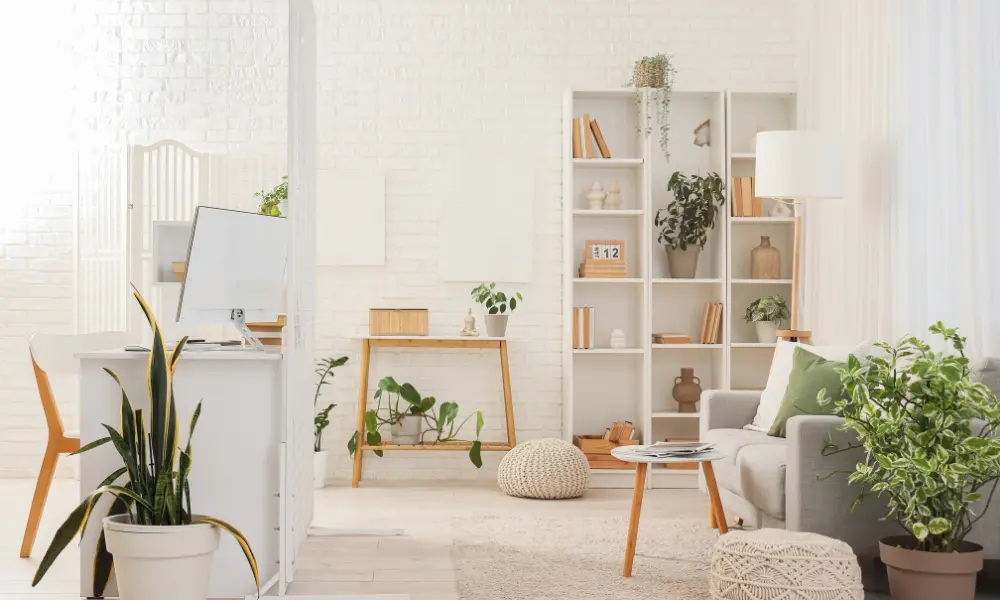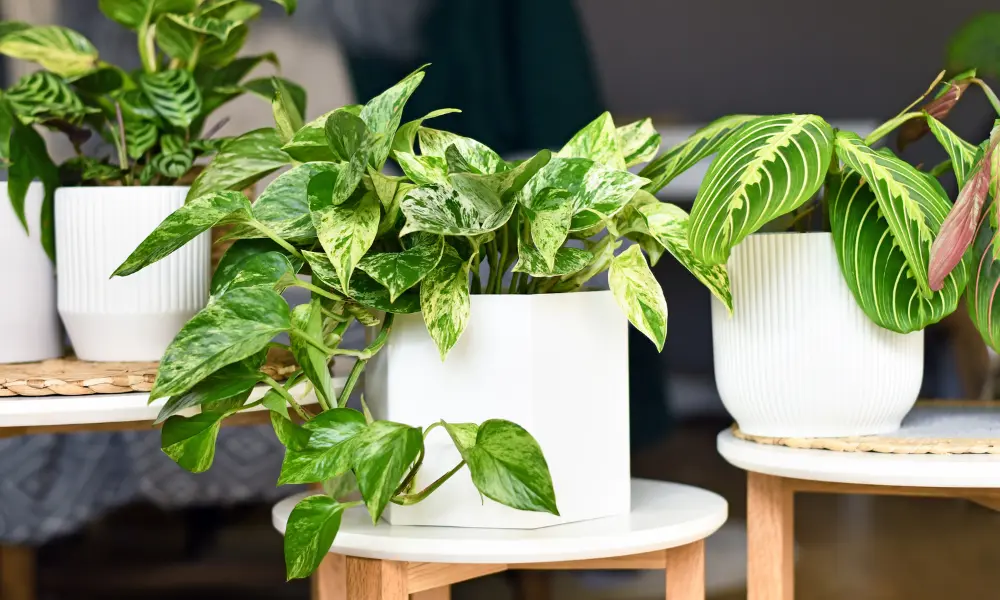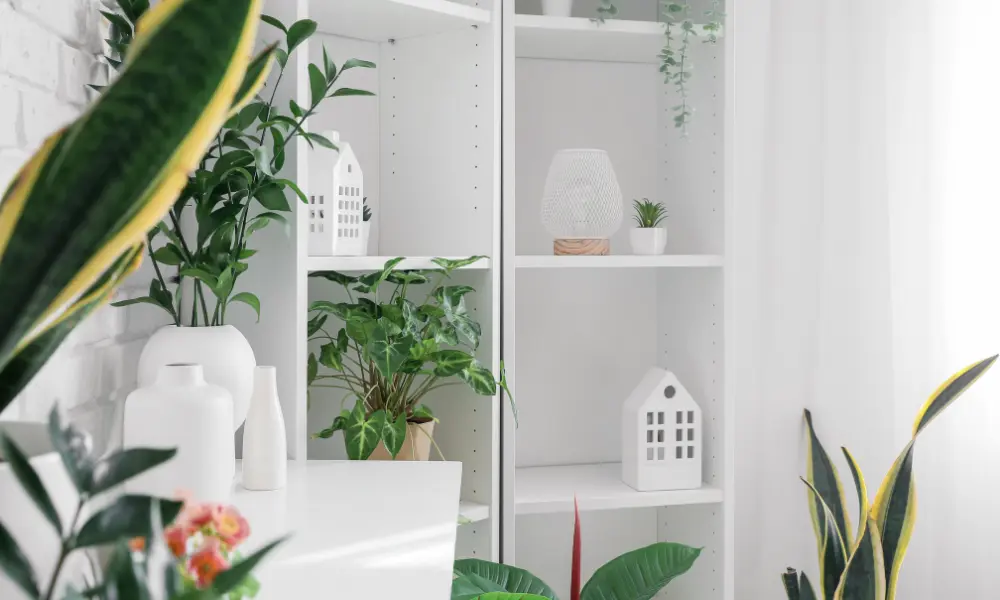
“Living room with clean decor and plants that enhance small spaces”
Do you love the idea of having plants at home, but think you lack space or time to care for them?
The good news is that there are perfect plants for minimalist and compact spaces — and they can transform any corner into an oasis of well-being.
In this article, you will discover the 10 best plants for minimalist and compact spaces , ideal for those seeking beauty, practicality, and almost no maintenance effort.
Want to find out which ones they are and how to use them without compromising your clean decor?
Continue reading and get inspired! 🌿
Why Choose Plants for Minimalist Spaces?
Having plants indoors goes far beyond aesthetics. When chosen well, they integrate into the minimalist lifestyle and offer benefits that directly impact your well-being and the quality of the space. Here’s why these green allies are so valuable:
The Importance of Green in Small Spaces
In compact spaces, every element should have a purpose. Plants serve as a multifunctional solution: they decorate, purify the air, and bring life to the space without creating visual clutter. A single well-placed pot can balance the neutrality of light tones and straight lines.
Furthermore, greenery connects you to nature, promoting feelings of calm and balance, essential for those seeking a cozy and functional home.
How plants enhance well-being and tranquility
Studies show that visual contact with plants reduces stress, improves concentration, and even enhances sleep quality. In a minimalist home, this is amplified: the absence of visual distractions highlights the presence of green, making the experience even more immersive.
Having a plant nearby is a daily reminder of care, presence, and renewal.
Clean aesthetics with natural touches
Minimalism values the essential, and the right plants can be the perfect focal point in neutral decor. Species with sculptural foliage or deep green tones add contrast without visually cluttering the space.
Combined with natural materials like wood, fibers, and ceramics, plants create a light, sophisticated, and organic atmosphere — ideal for those seeking balance between style and simplicity.
What to Consider Before Choosing Your Plants for Minimalist Spaces
Before randomly buying pots and species, it’s important to understand that in small, minimalist spaces, every choice needs to be intentional. This includes the type of plant, where it will be placed, and the care it requires.
Here are the main points to consider:
Lighting and ventilation
Light is a determining factor for the survival and beauty of your plants. Some species need direct sunlight, while others thrive in indirect light or partial shade.
Observe the availability of natural light in your space and choose plants compatible with that condition. Ventilation is also essential to prevent moisture buildup and the emergence of fungi or pests.
Size and proportion
In a minimalist environment, visual excess disrupts harmony. Therefore, choose plants proportional to the available space, prioritizing those that grow slowly or are already small.
Hanging plants, mini succulents, or species that grow vertically are great options to maintain the lightness of the space without occupying useful areas.
Maintenance level and basic care
The idea is to bring nature indoors, not to create more tasks or stress. Prefer easy-to-care-for plants that require little watering, adapt well to indoor spaces, and are resilient.
This type of plant is ideal for those with a busy routine, who travel frequently, or are just starting to cultivate the habit of caring for a green corner.
The 10 Best Plants for Minimalist and Compact Spaces

“Compact and easy-to-care-for plants are ideal for enhancing small spaces with visual balance.”
If you’re looking for a touch of green that harmonizes with clean decor, without taking up much space or requiring intensive care, this selection is for you. Below are the 10 best plants for minimalist and compact spaces, chosen for their beauty, practicality, and perfect proportion for small spaces.
1. ZZ Plant (Zamioculcas zamiifolia)
With firm foliage and a natural shine, the ZZ plant is one of the most beloved plants in minimalist style. It grows slowly, requires little watering, and adapts very well to locations with indirect light.
Ideal for indoor environments like living rooms and hallways, it conveys elegance and takes up little space.
2. Snake Plant (Sansevieria trifasciata)
An icon of resilience, the snake plant is perfect for those who want a sculptural plant with a strong presence. Its vertical shape saves space, and its graphic look pairs well with straight lines and neutral palettes.
It requires low light and almost no watering, making it ideal for apartments with moderate lighting.
3. Pothos (Epipremnum aureum)
If you want a versatile plant that can be used in hanging pots or on high shelves, pothos is the right choice. Its leaves in shades of green and yellow create a light and organic visual effect.
It grows quickly and helps purify the air, making it perfect for living spaces.
4. Peperomia (Peperomia obtusifolia)
Compact, charming, and low-maintenance, peperomia is excellent for side tables, shelves, or countertops. Its rounded, thick leaves create a cozy and contemporary look.
It likes indirect light and adapts well to different humidity levels.
5. Mini Cacti (various species)
For those seeking a minimalist touch with personality, mini cacti are the right choice. Small, resilient, and with varied shapes, they fit perfectly in niches, desks, or windowsills.
They require very little water and love direct sunlight.
6. Assorted Succulents
Succulents are favorites in minimalist environments due to their clean aesthetics and simple care. Available in numerous shapes and colors, they pair well with ceramic, cement, or glass pots.
Ideal for beginners who want to explore the world of plants lightly.
7. Spider Plant (Chlorophytum comosum)
Also known as the airplane plant, the spider plant has arched, striped leaves that bring movement to the environment. It can be grown in hanging pots or on shelves.
Besides being beautiful, it helps purify the air and adapts well to different light conditions.
8. Prayer Plant (Maranta leuconeura)
With patterned leaves and a “color-changing” effect as the day progresses, the prayer plant is perfect for adding a tropical touch without exaggeration. It loves shade and moderate humidity.
Its vibrant look complements neutral environments, adding emphasis without disrupting the harmony of the space.
9. Pilea (Pilea peperomioides)
Called the “friendship plant,” pilea charms with its round, symmetrical leaves. Compact in size, it is ideal for shelves, sideboards, and small decorative pots.
It requires diffused light and moderate watering. It’s one of the most photogenic species for those who like to decorate with style.
10. Mini Arrowhead Plant (Syngonium podophyllum ‘Pixie’)
The mini arrowhead plant is perfect for creating small arrangements or a minimalist terrarium. Its leaves in shades of green and white add lightness to the space without being visually heavy.
It adapts well to partial shade and doesn’t require constant care, making it ideal for the urban routine.
How to arrange plants in a minimalist space
Choosing the right plants is just the beginning. In a minimalist space, how you position and organize the pots also makes all the difference in the final composition.
Here are some strategies to integrate greenery into your space in a light and functional way.
Hanging pots and floating shelves
Hanging plants are perfect allies in compact spaces. They save floor space and add vertical movement, creating a sense of spaciousness.
Use lightweight pots and discreet supports made of rope, metal, or macramé to maintain a clean look. Floating shelves are also great for displaying succulents or pileas without compromising circulation.
Niches and discreet supports

Avoid occupying useful surfaces like daily-use countertops. Prefer built-in niches or elevated supports that allow you to include greenery without hindering the functionality of the spaces.
A niche with indirect lighting, for example, can transform a simple plant into a focal point of the decor.
Avoid excess: less is more in composition
Even with small species, accumulating too many pots can disrupt the harmony of the spaces. Choosing the right plants and positioning them intentionally is essential — as we show in this article about How to Decorate with Plants Without Visually Cluttering the Space
Remember: in minimalism, every element has a purpose. A single well-chosen plant can be more impactful than several poorly positioned ones.
Benefits of having plants at home
Incorporating plants for minimalist and compact spaces is not just an aesthetic choice. They also directly influence your physical and emotional well-being, bringing benefits that go far beyond decoration.
Air purification
Some species, like the snake plant and spider plant, are known for their ability to filter toxins and improve air quality. Having plants at home helps reduce common pollutants, such as formaldehyde and benzene, released by furniture, fabrics, and cleaning products.
The result is a healthier space, especially in enclosed spaces with poor ventilation.
Stress reduction
Studies show that contact with greenery can decrease levels of anxiety, stress, and mental fatigue. The presence of plants invites pause, conscious breathing, and slowing down — aspects that perfectly match a minimalist lifestyle.
Caring for a plant, even for a few minutes, can become a ritual of connection and presence in daily life.
Encouraging presence and mindfulness
Having a plant at home is a subtle reminder that life happens in the now. Observing a leaf grow, noticing the need for water, or repositioning the pot to receive more light are small gestures that cultivate mindfulness and connection with the present moment.
This type of interaction strengthens the bond with the space and helps make the home a true refuge of calm and authenticity.

To make your choice easier, we’ve put together a comparison table below with the 10 best plants for minimalist and compact spaces. This way, you can quickly assess which species best suit your lifestyle, available space, and the lighting conditions in your home.
Use this guide as a starting point to create a green corner with purpose and lightness.
Comparison Table – Plants for Minimalist Spaces
| Plant | Size | Care | Ideal Lighting | Toxic to Pets |
|---|---|---|---|---|
| ZZ Plant | Medium | Low watering | Indirect light | Yes |
| Snake Plant | Medium | Low maintenance | Indirect light or sun | Yes |
| Pothos | Medium | Easy to care for | Diffused light | Yes |
| Peperomia | Small | Moderate watering | Indirect light | No |
| Mini Cacti | Small | Minimal watering | Direct sun | No |
| Assorted Succulents | Small | Low watering | Sun or partial shade | Depends on species |
| Spider Plant | Medium | Low maintenance | Indirect light | No |
| Prayer Plant | Small | Likes humidity | Shade or diffused light | No |
| Pilea | Small | Moderate watering | Diffused light | No |
| Mini Arrowhead Plant | Small | Low maintenance | Indirect light | Yes |
Now that you know the characteristics of each plant, it’s easier to choose the one that fits perfectly into your space — without compromising the clean aesthetics, functionality, and tranquility that minimalism proposes.
Remember: a well-chosen plant transforms, inspires, and connects. And even in the smallest spaces, green can flourish with elegance.
Conclusion
Living with less doesn’t mean giving up the essential — and green is undoubtedly one of those essences. By choosing plants for minimalist and compact spaces, you are not just decorating your home, but creating a healthier, more balanced, and vibrant space.
The species listed here combine beauty, functionality, and simplicity, qualities that directly resonate with a more conscious lifestyle. Even in just a few square meters, it’s possible to cultivate a deep connection with nature, as long as choices are made intentionally.
Start small. Choose a plant, observe it, learn from it. Soon, you’ll realize that this small gesture has the power to transform the space — and you.
Your minimalist home deserves this touch of green.🌿
